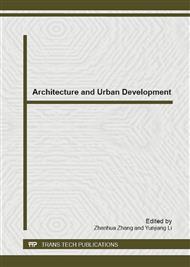p.57
p.62
p.67
p.71
p.75
p.83
p.87
p.92
p.96
Development of a Sustainable Aged Residential Model Considering Aged-Friendly Environmental Factors
Abstract:
Recently, aged residential designs throughout the world have begun to focus on the protection of residences for the aged by partnership with the local community in order to maintain the self-sustainable life of the elderly. As a result, various measures and infrastructure changes are being established to afford a comfortable residential life for the aged and to help solve the residential instability and health problems of the elderly. The purpose of this study is to develop a small multi-functional aged residential model that is based on local community involvement and one that can provide a sustainable residential environment for the elderly. In order to do so, this study will deduce aged-friendly environmental factors and identify the daily support services that are necessary in such a residential environment.
Info:
Periodical:
Pages:
75-82
Citation:
Online since:
November 2012
Authors:
Price:
Сopyright:
© 2012 Trans Tech Publications Ltd. All Rights Reserved
Share:
Citation:


